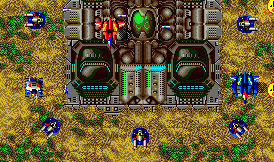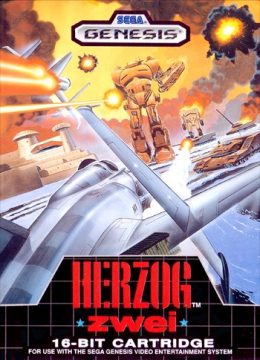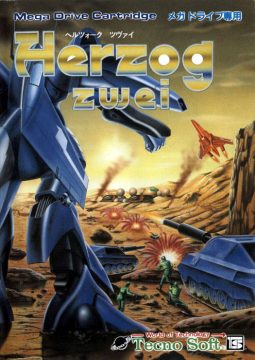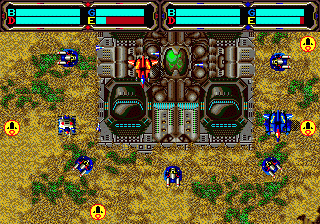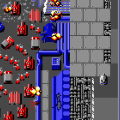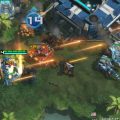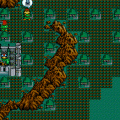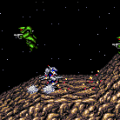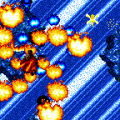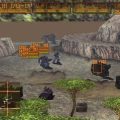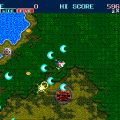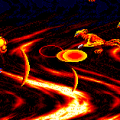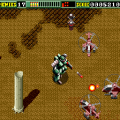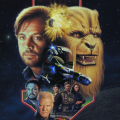- Herzog
- Herzog Zwei
- AirMech: Combat Transformed
At first sight, the Mega Drive/Genesis follow-up to Herzog, appropriately titled Herzog Zwei (“zwei” means two) looks like a free-scrolling shoot-em-up a la Time Pilot or the original Thunder Force, but that couldn’t be farther from what it actually is. Rather, it takes some of the elements of its predecessor, opens up the playing field beyond a mere corridor, and drastically expands on every aspect. All the RTS genre’s defining tropes – multiple infantry classes, different terrain types to overcome, objectives to clear and capture, among others – are present here, but what makes Technosoft’s pioneering title unique is the degree of player action involved in the gameplay.
Herzog Zwei, unlike most other RTSes, is focused squarely on multiplayer matches, with the objective of each match being the destruction of your enemy’s motherbase (the game CAN be played solo, but the mechanics and objectives in single-player are the exact same as those in multiplayer, making it more of a practice mode than anything). To do so, players must capture the minor bases spread through their map of choice and use them to increase their gold-per-second gain, which can then be invested into new units, which can in turn be used to capture more bases or to attack your enemy’s army and/or motherbase.
As to be expected from an RTS, different units have their own stats and selectable tactics, with all of them having access to the Secure Base, Stationary Guard, Circular Patrol, Shoot on Sight and Attack Enemy Motherbase commands except for Supply Trucks, which can only supply other units with fuel and ammo, and Turrets, whose high production costs and stationary nature is balanced out by their outstanding offensive capabilities.
The weak and expendable foot soldiers (known in-game as Infantries) are the only units capable of capturing minor bases and thus are the most important in most scenarios, but this certainly doesn’t undermine any of the other units’ importance. Most of the time you’ll be using Armored Cars and/or Tanks to attack enemy troops all around the map, but when the need arises, the fragile but extremely fast Speedbikes can be used in quick-and-dirty distractions and/or blitz tactics while the all-powerful but stationary turrets can be set in strategic points of the map to hinder your opponent’s progress.
Players are offered a choice of eight maps (whose names are all in German, a language which the Japanese seem to adore) at the beginning of each match, with each of them offering an unique challenge due to their different terrain. Units can easily get stuck on Abgrund’s valleys, Vulkan’s magma flows damage anything on contact, Loch’s thin strips of land and large mountain ranges can crank out some serious trench warfare strategies from experienced players, Strand’s scattered island bases makes anything but hit-and-run tactics fairly useless, Stadt is a fairly straightforward, no-holds-barren affair, Eisfrei offers equal opportunities for both land and aquatic combat on its snowy landscape, while the murky bogs of Waldung and Oase’s arid sands are by far the most challenging maps in the game, with plenty of uneven terrain and murky waters for your units to play through. Armored Boats can be used in Strand, Eisfrei and Oase as aquatic equivalents to Armored Cars, opening up more offensive and defensive strategies for players who pick those maps.
Resource management is quite a simple affair, with players only having to focus in keeping their health and energy levels high and their finances stable. Gold, as explained before, is gained on a per-second basis in multiples of forty (with more being awarded the more bases the player has captured), and is used to produce troops and apply commands to them. Energy (represented by the E gauge in the game’s HUD and the unit management and production screens) is what gives Herzog Zwei its unusually frantic pace that sets it apart from later RTSes, since its consumption upon movement is sure to keep players on their toes at all times.
The Commander the player controls is from where most of Herzog Zwei’s uniqueness stems from, as it works not only as a cursor for picking up and transporting units, but also as a unit onto itself. Its standard form is that of a jet who can carry units around and shoot the opposing Commander, but with a tap of the A button, it transforms into a bipedal mecha who doesn’t move very quickly, but is Energy-efficient and can shoot any ground unit in all eight directions. This motivates players to act not as an omnipotent god with total control over their units, but as a soldier who fights alongside them, which is something you usually don’t see in most RTS games. All other units in the game are AI-controlled and independent from any commands besides the ones you set them up with before production, which can often make Herzog Zwei feel more like a proto-MOBA than a typical RTS.
This, however, brings up what may be Herzog Zwei’s biggest issue: the AI just isn’t very good. At all. When deployed, units will try to take the shortest path possible to their objectives – be it an unguarded enemy base, a neutral outpost or the opposing player’s motherbase – which almost always leads them right into enemy traps… when they’re not busy wasting their Energy reserves by being stuck on bad terrain, that is. This often forces players to work alongside their units even when they shouldn’t by carrying around helpless units, putting them back on their tracks and refilling their health, Energy and Ammo reserves by towing them over to the nearest available base.
Another annoying aspect of Herzog Zwei are its controls, which often feel laggy, unresponsive and just a tad too finicky, especially when aiming your shots in the Commander’s mech form and picking up units in jet form (which is also done by tapping the A button, further aggravating this issue). By giving the Commanders such janky controls, Herzog Zwei seems to motivate players to leave all the dirty work to their units (which makes sense, considering the context of the genre), but when the unit AI is as poor as it is here, this feels more like a big oversight than a proper design decision.
Herzog Zwei’s presentation may look a tad dated, but when considering its release date and the fact that it was the first original game the company developed for Sega’s 16-bit console, one learns to appreciate the formidable effort put in the game’s graphics department, especially how each map has its own unique tileset for its terrain and how units are easily discernible from one another despite their small size. The soundtrack features the memorable compositions and incredible instrumentation one expects from a Technosoft title of the time, with some tracks in particular standing out for their usage of drums and heavy bass over the typical Technosoft guitar riffs (although no song will ever surpass Thunder Force III’s “Truth – Gorgon Stage Theme” when it comes to awesome drums, period).
Herzog Zwei may look very primitive and unrefined from a modern RTS player’s standpoint, but by giving it a chance, you’ll discover one of the most interesting, influential and downright fun games of the genre’s early days; one which still stands to the tests of time despite its low-scoring magazine reviews at launch, especially when played with a friend. Unfortunately, Herzog Zwei was the last RTS game Technosoft would produce (a sequel supposedly was to be released for the SEGA 32X, but the add-on’s commercial failure led to its cancellation), but its legacy as the grand-daddy of both classics like Dune II and modern fan-favorites such as Brutal Legend and Defense of the Ancients has left an undeniable mark in the genre, one which North American indie developer Carbon Games would tap into in 2012 when creating their free-to-play cult hit AirMech.
